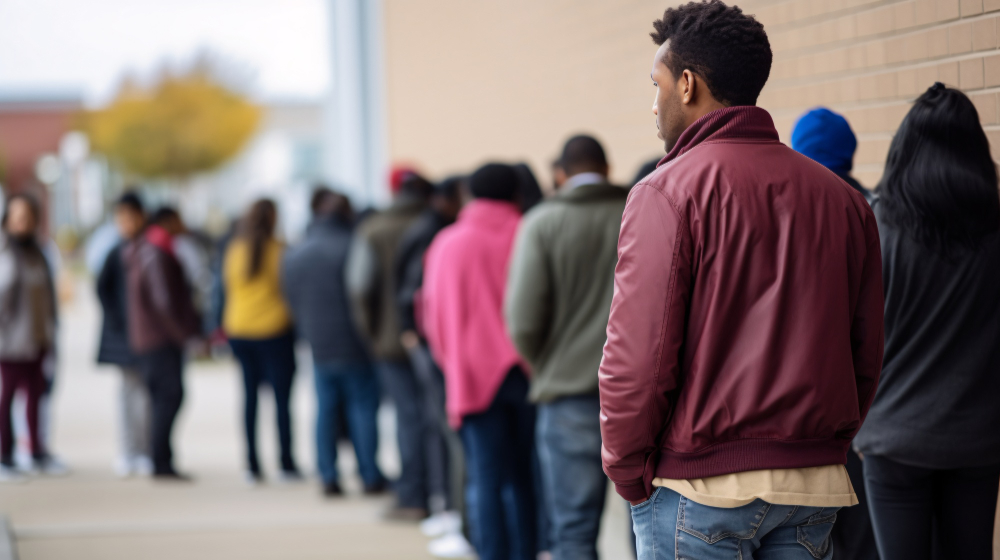In recent decades, the world population has faced a series of extreme weather events, such as long droughts, floods, high temperatures, blizzards, hurricanes, tornadoes, etc. Despite ideological minorities who believe in conspiracy theories or who deny science, there is a growing consensus regarding the impacts of human activity on the climate, especially due to economic activities driven by the Industrial Revolution that began in the 18th century.
The United States does not escape from the effects of Climate Change. The memory of the disaster caused by Hurricane Katrina in 2005 lives on. The storm killed 1,800 people and caused USD125 billion in damage. In 2017, Hurricane Maria killed 2,975 people in Puerto Rico alone and caused USD91.1 billion in damage.
In 2021, the United States faced a series of extreme weather events, such as heavy snowfall in the state of Texas in February, flooding in the state of Arizona in August, wildfires on the West Coast, the Hurricane Ida that hit Louisiana (second strongest after Katrina), and a tornado that devastated parts of Illinois, Missouri, Kentucky, and Tennessee in December.
Natural disasters caused by extreme weather events impact the entire population of the regions affected. Still, the intensity of these impacts is not felt in the same way by all social groups. Generally, because they live in places with less infrastructure or carry out professional activities with a lower level of qualification, the poor are the most affected. As in the United States, the worst social indicators are related to African American and Latino/Hispanic groups, the most harshly impacted by Climate Change.
The study analyzes the impact of climate change based on six variables: (a) Health and air quality; (b) Health and temperature extremes; (c) Work and temperature extremes; (d) Coastal traffic and flooding; (e) Properties and coastal flooding; and (f) Property and flooding within the country. The analysis presented in the report first identify areas in the contiguous United States (USA) where impacts are projected to be the highest under future global temperature changes and sea-level rise. The study estimates some possibilities of impact on the lives of those who are socially vulnerable, comparing those who live with those who do not live in these areas. Of the four socially vulnerable groups examined, minorities are most likely to currently live in areas where analyzes project the highest levels of climate change impacts, such as a 2 °C rise in global temperature and a 50 cm rise in sea level. In this sense, the research reports:
• Black and African American individuals are 40% more likely than non-Black and non-African American individuals to currently live in areas with the highest projected increases in mortality rates due to climate-driven changes in extreme temperatures. In addition, Black and African American individuals are 34% more likely to live in areas with the highest projected increases in childhood asthma diagnoses due to climate-driven changes in particulate air pollution.
• Hispanic and Latino individuals are 43% more likely than non-Hispanic and non-Latino individuals to currently live in areas with the highest projected labor hour losses in weather-exposed industries due to climate-driven increases in high-temperature days. Hispanic and Latino individuals are also 50% more likely to live in coastal areas with the highest projected increases in traffic delays from climate-driven changes in high-tide flooding.
• American Indian and Alaska Native individuals are 48% more likely than non-American Indian and non-Alaska Native individuals to currently live in areas where the highest percentage of land is projected to be inundated due to sea-level rise. American Indian and Alaska Native individuals are also 37% more likely to live in areas with the highest projected labor hour losses in weather-exposed industries due to climate-driven increases in high-temperature days.
• Asian individuals are 23% more likely than non-Asian individuals to currently live in coastal areas with the highest projected increases in traffic delays from climate-driven changes in high-tide flooding.
Furthermore, according to the research, “About eight-in-ten U.S. Hispanics (81%) say addressing global climate change is either a top concern or one of several significant concerns to them personally, with 39% saying it is a top personal concern. By comparison, for a lower share of non-Hispanics (67%), addressing global climate change is at least one of many critical concerns, due in large part to a lower share who say it is a top concern (29%). In addition, a greater share of non-Hispanics than Hispanics says that addressing global climate change is not a significant concern to them (32% vs. 18%)”.
The survey also found that most (56%) of US Hispanics say their area has experienced an extreme weather event in the past year. It has to be considered that California, Texas, and Florida are home to more than half of the Hispanic population in the country, and the Hispanic population of each state has increased by more than 1 million from 2010 to 2020. These states have recently experienced increased wildfires, extreme heat, blizzards, drought, and floods. Another important finding is that Hispanics are also more likely than non-Hispanics to think that human activity, such as burning fossil fuels, contributes in part or large part to global climate change (84% vs. 76).
This perception of the Latino/Hispanic voters is very relevant if we consider that the issue of climate change promotes heated debates among most Democratic and Republican voters, with the first being enthusiasts of the topic and the second being harsh critics of environmentalism. Democrats defend energy conversion, as does Joe Biden's proposal for a New Green Deal. Republicans, on the other hand, continue to advocate the use of energy sources based on fossil fuels, such as oil, shale oil, and coal. Because of this division, including among Democrats, the environmental part of Build Back Better (BBB) remains blocked in congressional debates, mainly by the action of Senator Joe Manchin (D-WV), who
stated on February 1, 2022, that the BBB was dead.
The issue of climate change is sensitive among the Latin/Hispanic community because most of its contingent is concentrated in regions that have suffered a lot from extreme weather events, such as the hurricanes that hit the Gulf of Mexico and the Atlantic coast, rising sea levels that have caused flooding in urban areas of South Florida, the high temperatures that cause wildfires in California, in addition to the drop in the supply of electricity and drinking water. The situation is quite critical in the “Golden State,” as highlighted by
The Guardian. “Water agencies in drought-stricken California that serve 27 million residents and 750,000 acres of farmland won’t get any of the water they have requested from the state heading into 2022 besides what’s needed for critical health and safety, state officials announced on Wednesday. (December 01, 2021). It’s the earliest date the department of water resources has issued a 0% water allocation, a milestone that reflects the dire conditions in California as drought continues to grip the nation’s most populous state and reservoirs have dropped to historically low levels”.
In addition to the economic impacts of the prolonged drought in California, the social impacts must be considered, as the state's agriculture employs hundreds of thousands of immigrant workers, many of them temporarily, as they are only admitted during the harvest period, mainly for fruit. Furthermore, as highlighted by the EPA research cited above, these workers are subjected to extreme weather conditions, such as high temperatures.
In Florida, the impacts of climate change are proving more challenging. The Miami metropolitan region is most exposed to sea-level rise and hurricanes. According to the
New York Times, “South Florida, flat and low-lying, sits on porous limestone, which allows the ocean to swell up through the ground. Even when there is no storm, rising seas contribute to more significant tidal flooding, where streets fill with water even on sunny days. The expanding saltwater threatens to spoil the underground aquifer that supplies the region’s drinking water, and to crack old sewer pipes and aging septic tanks. It leaves less space for the earth to absorb liquid, so floodwaters linger longer, their runoff polluting the bay and killing fish”.
News from
Business Insider exemplifies this problem when reporting the difficulties of a resident of the Shorecrest neighborhood of Miami: “When the flooding is awful, water doesn’t just fill the streets outside Manolo Pedraza’s house. It bubbles up through a shower drain. Pedraza lives in Shorecrest, a northern Miami neighborhood that faces flooding, so regularly it happens even when it hasn’t rained. All it takes to fill the streets to knee-high depth on those days is a full moon. The flood comes up through storm drains, making it impossible to navigate without encountering the water, which is mixed with sewage and whatever else it picked up along the way.”.
Considering that the region is very vulnerable to sea-level rise, the poorest regions of the city, far from the beaches and therefore in higher places and not subject to flooding, are being threatened by the process of “gentrification,” that is, the poorest population is being expelled from their homes by the increase in rent prices and better-off residents have been occupying the space due to a new wave of real estate investments. This is the case of the “Little Haiti” neighborhood. According to the Master's Thesis by Elizabeth Santiago of the
University of Michigan, “Further away from the coveted beachfront properties, neighborhoods like Little Haiti have historically been regarded as less desirable than other parts of Miami. However, as a climate crisis encroaches, Little Haiti’s diversity and its relative protection from flooding and rapid sea level rise are drawing in households with high socioeconomic status”.
In addition to concerns about the impacts of climate change in the United States, it must be added that part of the Latino/Hispanic community faced extreme weather events in their countries of origin. It is worth mentioning that two major hurricanes hit Central America at the end of 2020, Eta and Iota, in less than two weeks. According to the
UN, “With the hurricane, food insecurity increased in Guatemala, which was already suffering from drought, reduced harvests, and economic difficulties caused by Covid-19. Before the passage of the Eta, some 3.3 million people in Guatemala were already suffering humanitarian needs. Now nearly 400,000 people have been displaced, and more than 650,000 need help”. Due to these natural disasters, the migratory flow from the Northern Triangle of Central America to the United States increased, even more, surpassing the flow of Mexicans, as we have already mentioned in previous analyzes of
this Latino Observatory.
Another weather event that echoed on Latino migration to the United States was Hurricane Maria in September 2017, which devastated much of the Caribbean islands, particularly Puerto Rico. Approximately 3,000 people died as a result of the storm. The island's infrastructure was virtually destroyed, as were thousands of homes and businesses. US government calculations estimate that approximately 200,000 people left Puerto Rico between 2017 and 2018, fleeing the
state of calamity left by the hurricane.
Given the context in which the effects of climate change heavily impact Latino communities, it is important to consider a broad Latin environmental movement. In the last update of
our website, the performance of the NGO Green Latinos was highlighted, especially the conference that brought together several environmentalists from the United States, the Secretary of Transport Pete Buttigieg, and representatives of major environmental organizations such as Greenpeace, WWF, EDF, among others.
Another useful piece of information concerns the degree of activism of Latinos. In the article “
Climate Change Activism Among Latino and White Americans”, Mattew Ballew et al. describe research showing that Latinos have pro-environmental strong and supportive of policies attitudes to reduce climate change compared to non-Latinos. “Key predictors of Latinos' significantly higher levels of political engagement include greater risk perceptions, egalitarian worldviews, pro-environment injunctive norms, collective political efficacy, and greater social network effects”.
In conclusion, it is important to mention that the environmentalist agenda is associated with progressive social movements linked to the Democratic Party. In this aspect, the most outstanding Latin leaders are aligned with this segment. As we have discussed in other analyses, the first year of Joe Biden's government was frustrating from the point of view of the most left-wing sectors of the Democratic Party, as in addition to not being able to reverse the restrictive immigration laws created in the previous administration, a package of measures in favor of the most vulnerable groups, the environmental agenda is at a standstill in Congress. Disillusionment about the difficulties in advancing the more progressive agenda could demobilize the great front formed in the 2020 elections in favor of Biden.
For their part, Republicans remain aligned with anti-environmental agendas and throw all their weight into blocking initiatives that put their financiers linked to traditional energy sectors, such as oil and coal, at risk. In the midst of political polarization, it is necessary to warn that the calendar of extreme weather events does not adjust to short-term electoral demands. Extreme temperatures, floods, wildfires, hurricanes, droughts, and all the associated health, economic and social problems should be at the top of the US political agenda. Sadly, they’re not.
 pexels.com
pexels.com











